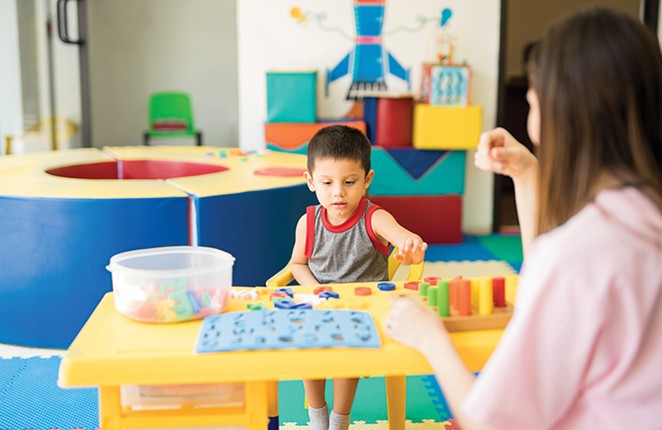Receiving news that your child has special needs can prompt a devastating turn of events. "The future you imagined, it's all changed," says Leslie Seidel, whose son Luke was diagnosed with autism at age two. Fortunately, early childhood special education resources are available through the High Desert Education Service District, which includes Bend-La Pine, Crook County, Redmond and Sisters school districts.
"Early childhood intervention can make a world of difference," says HDESD communications consultant Linda Quon, "especially for integration into a school environment." One important resource is the Alyce Hatch Center, where parents can have their child evaluated and then get plugged into any specialized services they might need as their child develops. "The HDESD has two programs for students with special needs," she explains. "Our Early Childhood Special Education program for students aged zero to five, and the Ray program (formerly called Central Oregon Regional Programs) for those aged Kindergarten through 21." Services for children up to three years old can also be provided in-home.
"They helped with every part of my life," Seidel says of the staff at Alyce Hatch. When she first heard the autism diagnosis, "it didn't mean anything," she says, because the word encompasses so many different things. "You're staring at a cliff. There's so much information coming at you. What is oxygen therapy? Why do I need to get these tests done? What is a sensory diet?"
Once a child enters elementary school, programs like the Bridges classroom at Lava Ridge Elementary School further facilitate mobility, learning and social skills. "We invite staff from the school districts to come and observe, practice and learn research-based teaching strategies. The classroom is staffed with specialists in autism, occupational therapy, augmentative communication and speech pathology, assistive technology and teachers for the hearing and visually impaired," says Quon. Those specialists are also available at the early childhood level.
Some middle- and high-school tech classes provide their students with opportunities to create tools for assisting special needs students. "We have developed a curriculum to learn problem solving, along with awareness and sensitivity," Quon explains. "How to view a computer screen with vision impairment or get around school with barriers." When a group of middle schoolers was presented with the challenge for mobility-impaired students to reach door handles on campus, for example, they created a prototype grabber with interchangeable ends for accomplishing multiple tasks.
Luke Seidel is now in second grade and attends the Bridges program at Lava Ridge in Bend. "Even now," his mom says, "I'm learning how to advocate, how to talk to people about him." The Seidels participate in annual autism walks, sponsored by the Central Oregon Autism Movement. According to the COAM website, the walk and carnival for individuals on the autism spectrum and their families is "a day of raising awareness, accessing resource information and just having fun." This year, Seidel has invited her friends with neurotypical ("normal") children to join her. "This will be a space where they will be outnumbered, they will get to be the standout, while watching (all of the kids) having fun."
Amy McCormick, director of early intervention and early childhood special education at HDESD, emphasizes the importance of societal acceptance for children, including the developmentally challenged. "Early support has a positive effect on brain development and can change a child's developmental trajectory," she says.
Seidel sees events such as the COAM autism walk as ways our society can lend invaluable support—and ultimately reap the benefits. "The earlier kids get the services they need, the better they are able to participate, to operate in the world," she says. "That serves all of society." McCormick says that statistically, when children receive the support they need growing up, society ultimately benefits from things like increased employment and decreased need for public assistance.
Every child is unique, among the general population and among those with special needs, and every child needs to feel accepted. So, Seidel says, if you'd like to be supportive for a friend or relative with a special-needs child, ask how you can help.
As for her son Luke, she says, "He is a person, just remember that. Slow down. Meet him. Learn his language." Luke is considered non-verbal, but he understands language, and he communicates in other ways. She says he is very aware of his emotional environment. "He understands everything. His emotional IQ is high. He sees when people are mocking him, even if he's not looking at them."
Seidel emphasizes that all parents want their children to be able to go everywhere and do everything other kids do. Awareness of the special needs that some children live with not only helps the special kids, but it allows others an opportunity to practice empathy and problem-solving. "Since age two, Luke's been in services up to 30 hours a week," she says. "It's work for him just to be in the world."
While many of the needs are being met, McCormick says there is an urgency to hire more special education teachers. "For our program, the hard-to-fill positions are the MA level teachers and BA or BS holders with specialized certification." Volunteers are also needed to work in classrooms, do project prep work or help with fundraising and other special events. Interested parties may contact McCormick at [email protected] or 541-312-1964.









